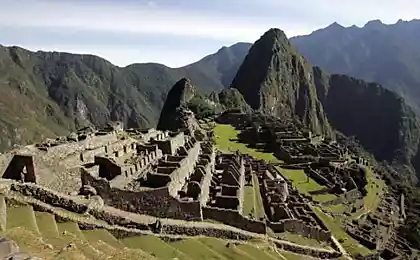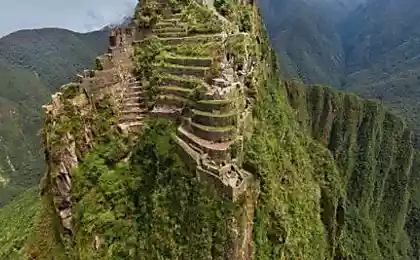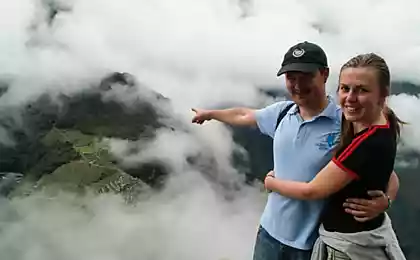203
City in the Clouds - Machu Picchu
Lost the city of Machu Picchu high in the Peruvian mountains. This is one of the wonders of the world that is still completely unsolved. The city is about 2,450 m above sea level, above the bustling waters of the rushing Urubamba River, which winds its rapids.
The stone city was discovered by the American explorer H. Bingham in the early twentieth century. Searched for the city of the Incas for many years, the explorers were at a loss, because on the way to the discovery they happened many similar cities. Working in eastern Peru in 1911, an American expedition had to settle on a halt on the coast of Mount Urubamba. There were Indians working on the slope, one of them offered his help and climbed with them to the top of the mountain so that they could see the ancient structures, thinking that the travelers were looking for them. This ascent was not in vain, archaeologists did not believe their eyes, when before them there was a city with powerful walls, which consisted of large stones, quietly stood small houses and other neat structures. And in the main square there was a working sundial.
Today, the name of the mountain is said to be called “the city among the clouds”, “the city in the sky”. Machu Picchu was inhabited for only 100 years, and in 1532 the inhabitants simply disappeared somewhere, just during this period the Spaniards invaded their territory. There were 200 buildings on the territory, of which 150 were Inca premises, and the rest were temples and residences.
The architecture is striking, especially the perfect lines. The clarity of the city layout is in harmony with the surrounding nature. One of the largest buildings is the Temple of the Sun. It is very interesting for tourists.
It has a detrimental effect on the impact of tourists on the city, which for so long existed perfectly without them. UNESCO is trying to force locals to reduce the flow of tourists, but the authorities of Peru are afraid of losing income to the treasury.
Source: /users/147
The stone city was discovered by the American explorer H. Bingham in the early twentieth century. Searched for the city of the Incas for many years, the explorers were at a loss, because on the way to the discovery they happened many similar cities. Working in eastern Peru in 1911, an American expedition had to settle on a halt on the coast of Mount Urubamba. There were Indians working on the slope, one of them offered his help and climbed with them to the top of the mountain so that they could see the ancient structures, thinking that the travelers were looking for them. This ascent was not in vain, archaeologists did not believe their eyes, when before them there was a city with powerful walls, which consisted of large stones, quietly stood small houses and other neat structures. And in the main square there was a working sundial.
Today, the name of the mountain is said to be called “the city among the clouds”, “the city in the sky”. Machu Picchu was inhabited for only 100 years, and in 1532 the inhabitants simply disappeared somewhere, just during this period the Spaniards invaded their territory. There were 200 buildings on the territory, of which 150 were Inca premises, and the rest were temples and residences.
The architecture is striking, especially the perfect lines. The clarity of the city layout is in harmony with the surrounding nature. One of the largest buildings is the Temple of the Sun. It is very interesting for tourists.
It has a detrimental effect on the impact of tourists on the city, which for so long existed perfectly without them. UNESCO is trying to force locals to reduce the flow of tourists, but the authorities of Peru are afraid of losing income to the treasury.
Source: /users/147























